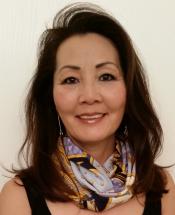Featured Image Courtesy Ground Penetrating Radar Image Courtesy Jamie Brandon
The Preservationist’s Primer for Nondestructive Testing and Evaluation
Speaker Bios
 |
Shari Kamimori is a Design Professional with over 25 years of experience in the architectural design field. She is President and founder of 3D Virtual Design Technology, Inc., a digital survey firm based in San Francisco and Sonoma providing 3D and 2D as-built documentation using 3D laser scanning technology for the architectural, engineering and construction (AEC) industry. She holds a B.S. degree in Interior Architecture and has worked for and partnered with architectural and engineering firms in the United States and Germany. She is actively involved in historic preservation, serving as a Board Director for Napa County Landmarks and Sonoma League for Historic Preservation and is a member of the California Preservation Foundation Education Committee. 3D imaging technology is used to digitally preserve cultural heritage sites and historic buildings at risk of destruction and/or deterioration, for conservation/preservation efforts, as well as to produce documentation for HABS/HAER mitigation. 3DVDT implemented 3D laser scanning technology on several historical buildings damaged by the South Napa Earthquake, for seismic retrofitting, damage assessment, restoration and was used as a safety measure to pre-manufacture a stabilization containment for an extensively damaged historic listed building. Shari has published an article in LiDAR News, titled “3D Laser Scanning Technology – Key in Preserving Historic Structures After South Napa Earthquake”. |
| Sapna Marfatia is an Architect with a bachelor’s degree in architecture and a Master in Urban Design she is currently pursuing a second Masters in Liberal Arts. She has been in this profession for over twenty five years, with fifteen years at Stanford University. Her experience spans the fields of Architecture, Planning, Urban Design and Historic Preservation. At Stanford she has worked on a variety of projects from a micro to a macro level. She provides direction and tone for the expression of architecture at Stanford University. She also provides expertise on the preservation and long term maintenance of iconic Stanford buildings, such as the Main Quad, Memorial Church, Hoover Tower and Hanna House. Sapna has served on the AIA board of Directors and as Historical Commissioner for The City of Los Altos. | |
 |
Mr. Mark Olson is a California-registered professional geophysicist and geologist, and certified hydrogeologist, with over 25 years of experience performing geophysical and geological investigations. Mr. Olson is responsible for the management and technical performance of all of the firm's projects.Mr. Olson was formerly a senior geologist/geophysicist with Dames & Moore in Los Angeles and manager of their international geophysical services group. During his employment with Dames & Moore he performed numerous geophysical surveys for subsurface investigations related to subway tunneling, geotechnical investigation of dams, and environmental and groundwater studies. Mr. Olson was also a senior geophysicist with Mobil Exploration and Producing Services in Dallas, Texas. During his employment with Mobil Oil he was involved with onshore and offshore seismic data acquisition, seismic data processing, and interpretation of geological and geophysical data for oil and gas exploration. |
 |
Mr. Armen Tajirian has over 45 years experience in providing consulting materials engineering services to the construction industry. Services include failure analysis, structural investigations, evaluation of unreinforced masonry buildings, earthquake damage assessments, environmental assessments, architectural investigations of building envelopes, evaluation of concrete problems, materials testing, specialty inspection, review of plans and specifications, and R&D of new products.In conjunction with above work, Mr. Tajirian provides support to structural engineers, architects, building owners, contractors, insurance agencies, building managers and other consultants. He has provided expert witness testimony in construction related litigation cases. Mr. Tajirian has also acted as project manager to lead a team of engineers or other professionals on multiphased consulting projects. Typically, a project would go through an investigative phase, followed by a comprehensive written report with recommended remedial work phase, and finally an inspection of remedial work phase.In his forensic analysis, Mr. Tajirian frequently uses Non-Destructive Testing (NOT) to evaluate construction materials. Equipment he utilizes include: Ground Penetrating Radar (GPR), Ultrasonic Testing (UT), Schmidt hammer, moisture meter, and borescope. |
 |
Christopher Wasney brings a wealth of expertise to designing and managing challenging projects for universities, community-based institutions and non-profits. A founding principal of CAW Architects, Inc., Chris directs the firm’s higher education and historic preservation work, including 100 projects at Stanford University, U.C. Santa Cruz, and U.C. Berkeley, as well as numerous commercial interiors and residential projects. Chris particularly relishes the challenges of finding appropriate and distinctive design responses within established buildings and campuses. He is skilled at balancing the demands of program, preservation, and budget, and thrives in the hands-on role as a team leader from project inception to closeout. His work includes new buildings as well as large-scale renovations and adaptive reuse projects on historic buildings. Chris is on the faculty of the Architectural Design Program at Stanford University and the Board of Directors of the California Preservation Foundation. |
Draft Agenda
Handouts
- 1.SapnaMarfatia-StanfordNDE
- 2.ShariKamimori_PP.pdf
- 2.ShariKamimori_Summary
- 3.AGI Substructure Archaeological and Concrete GPR SOQ 11-14
- 4.ArmenHandout
Learning Objectives
- Examine and use the latest technology for nondestructive evaluation and testing of historic structures
- Identify the appropropriate tools for various materials, settings, and conditions
- Through a study of case examples, understand costs, time commitment, and feasability of the various evaluation methods and tools
- With hands-on demonstrations, properly use and understand the basic functions of NDE / NDT tools
